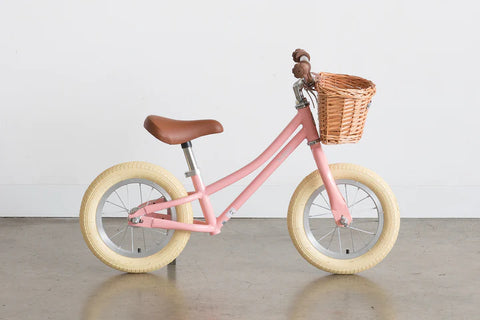Balance Bikes Triumph Over Tricycles
Tricycles have long been a popular choice for young children learning to ride. But have you considered the advantages of balance bikes?
Tricycles offer stability, sure. Versus toddler balance bikes with a unique and effective approach for future biking success. In this post, we’ll break down the benefits of the latter and why they may be the superior choice for your little ones.
Tricycles for Kids

Tricycles are three-wheeled bicycles designed to help young children learn how to ride. As with any other kids’ bikes, this type aims to develop their motor skills. They typically have a stable and sturdy frame and a low centre of gravity, and a seat.
While tricycles can be a popular choice for parents, there are a few downsides to consider. First, they can be quite heavy and bulky. In most cases, this makes it difficult for young riders to manoeuvre and control.
Another drawback is that they can hinder a child’s balance development. Since tricycles have three wheels, they provide a high level of stability. This means children don’t need to actively balance themselves. This can delay the development of coordination skills that are crucial for independently riding later on.
Instead of a tricycle, a balance bike is often considered a better alternative.
Introducing 12 inch Balance Bikes
Childrens balance bikes are two-wheeled bicycles without pedals. This clever design allows kids to focus on developing their balance and coordination. By propelling themselves forward using their feet, they learn how to balance. Moreover, to master steering without the need for training wheels or stabilisers.
Using a child's balance bike helps children develop equilibrium and spatial awareness. These traits are vital for transitioning to a traditional pedal bike. Once children have mastered the skills of balancing, they can progress to a pedal bike. The best part? Without the need for training wheels and with confidence. This smoother transition saves time and effort compared to tricycles which require an extra step of learning to pedal.
Now, how about bikes with stabilisers or training wheels? They can also help children learn to ride, that’s for sure. However, they can create a dependency on the extra support. Stabilisers, for one, can limit a child’s ability to balance and make turning more difficult.
We recommend balance bikes as they promote a more natural learning experience. Additionally, young riders can develop their skills at their own pace.
In summary, while tricycle bikes can be appealing, they have some downsides. They can be heavy and bulky and hinder the development of balance and coordination skills. A balance bike, on the other hand, is a better alternative. It provides an easier transition to a traditional pedal bike. Training wheels, although an option, may prolong the learning process.
The Benefits of Balance Bikes
Balance bikes offer several benefits for young children learning to ride a bike. Here are some of the key advantages:
1. Balance and coordination development
Balance bikes are designed to teach children how to balance on two wheels. The key here is using their feet to propel themselves forward and control their speed. This helps children develop a strong sense of balance and coordination. Such a fundamental skill for riding a traditional pedal bike without training wheels.
2. Confidence building
The gradual learning process of balance bikes helps build confidence in young riders. Children can start by walking or scooting with their feet on the ground. Then, gradually lift their feet to glide.
As they gain confidence and control, they can lift their feet for long periods. They’ll eventually master the art of balancing. This progression allows children to set their own pace.
3. Easy transition to pedal bikes
Balance bikes focus solely on balance and coordination. Thus, children can easily transition to pedal bikes once they get the hang of it.
They’ll already have a good sense of balance and know how to steer. Again, this makes the transition smoother and quicker. Many children who start with balance bikes can skip training wheels altogether, saving time and effort.
4. Improved motor skills
Riding a balance bike involves physical movements that enhance motor skills. Children learn to coordinate their leg movements and use their arms for steering. Their core muscles are also targeted for balance.
These actions help develop their gross motor skills. What’s more, spatial awareness and overall physical coordination.
5. Safety
Balance bikes are generally safer than tricycles or bikes with training wheels. For one, children can easily touch the ground with their feet. It gives them more stability and control over the bike. This increased stability reduces the risk of tipping and grants safer riding.
6. Enhanced focus and concentration
Riding a balance bike requires children to focus on maintaining balance and steering. This concentration helps improve their ability to stay attentive while riding. It also enhances their spatial awareness and helps them navigate obstacles in the terrain.
7. Active outdoor play
Balance bikes encourage children to engage in active outdoor play. They provide an opportunity to enjoy the outdoors and develop a love for physical activity. Riding a balance bike promotes a healthy and active lifestyle from an early age.
Overall, balance bikes offer numerous benefits for young riders.
Did you know we offer balance bikes in a whole range of colours? From pink balance bikes, red balance bikes to yellow balance bikes, you can gift joy with one of our 12 inch balance bikes.
Round-up
Balance bikes have proven to be the superior choice over tricycles for young riders. They offer numerous advantages, as outlined in this blog.
So when starting their cycling journey, consider balance bikes as the preferred option. By introducing little ones to the world of balance bikes, they can set them up for a fulfilling and successful biking experience. Let the balance biking adventure begin! Check out our balance bike with basket, the beautiful Gingersnap.














